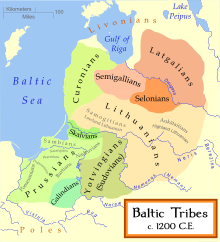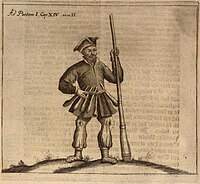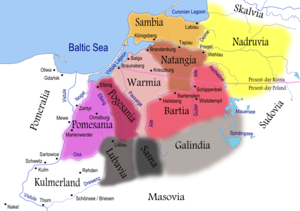Old Prussians
 The Old Prussians' territory in lime green, ca. 1200 AD. The boundaries are approximations. |
| History of Brandenburg and Prussia |
|---|
  |
|
| Present |
|
Old Prussians, Baltic Prussians or simply Prussians
The duchy of the
The original territory of the Old Prussians prior to the first clashes with the
Etymology
The name of the Old Prussians has its origin in toponymy, as the word Prūsas (a Prussian) can be derived from the term for a body of water, an understandable convention in a coastal region dotted with thousands of lakes, streams and swamps (Masuria). To the south, the terrain runs into the vast wetlands of the Pripet Marshes at the headwaters of the Dnieper River, which has been an effective natural barrier throughout the millennia.[9]
Writing in 98 CE, Roman historian
The original settlers tended to name their assets after surrounding localities (streams, lakes, seas, forests, etc.). The clan or tribal entity into which their descendants later were organized continued to use the names. This source is perhaps the one used in the very name of Prusa (Prussia), for which an earlier Brus- is found in the map of the Bavarian Geographer. In Tacitus' Germania, the Lugii Buri are mentioned living within the eastern range of the Germans. Lugi may descend from Pokorny's *leug- (2), "black, swamp" (Page 686), while Buri is perhaps the root on which the toponym "Prussia" is based.[11]
The name of Pameddi, the (
In the second century AD, the geographer Claudius Ptolemy listed some Borusci living in European Sarmatia (in his Eighth Map of Europe), which was separated from Germania by the Vistula Flumen. His map is very confusing in that region, but the Borusci seem further east than the Prussians, which would have been under the Gythones (Goths) at the mouth of the Vistula. The Aesti recorded by Tacitus, were 450 years later recorded by Jordanes as part of the Gothic Empire.[13]
Organization


The original Old Prussian settlement area in the western Baltics, as well as that of the eastern Balts, was much larger than in historical times. The archaeological documentation and associated finds confirm uninterrupted presence from the Iron Age (fifth century BC) to the successive conquest by Slavic tribes, beginning in the Migration Period.[14][15][2]
Permanent recorded
Around the year 1,000 AD, the
The smallest social unit in Baltic lands was the laūks, a word attested in Old Prussian as "field", which were small family oriented settlements, households and the surrounding fields, only separated from one another by uninhabited areas of forest, swamp and marsh.[18][19] The word appears as a segment in Baltic settlement names, especially in Curonian,[20] and is found in Old Prussian placenames such as in Stablack, from stabs (stone) + laūks (field, thus stone field). The plural is not attested in Old Prussian, but the Lithuanian plural of laukas ("field") is laukai.
A laūks was also formed by a group of farms, that shared economic interests and a desire for safety, ruled by a male head of the family and centred on strongholds or hill forts.[18] The supreme power resided in general gatherings of all adult males, who discussed important matters concerning the community and elected the leader and chief; the leader was responsible for the supervision of the everyday matters, while the chief (the rikīs) was in charge of the road and watchtower building, and border defense, undertaken by Vidivarii.
The head of a household was the buttataws (literally, the house father, from buttan, meaning home, and taws, meaning father). Larger political and territorial organisations, called terrula in Latin (a small land), existed in the early 13th century in the territories which later comprised Prussia, Latvia and Lithuania and centred on strongholds or hill forts. Such a political territorial unit covered up to 300 km2 (120 sq mi) and could have up to 2,000 inhabitants. They were known as pulka, comprising a dozen or so laukses.[21]
Because the
According to Jan Długosz, the Prussians, Samogitians, and Lithuanians were the same tribe.[23]
The Prussian tribal structure is well attested in the Chronicon terrae Prussiae of contemporary author Peter of Dusburg, a chronicler of the Teutonic Order. The work is dated to 1326.[24] He lists eleven lands and ten tribes, which were named on a geographical basis. These were:
| Latin | German | Polish | modern Lithuanian |
reconstructed Prussian |
see also | |
|---|---|---|---|---|---|---|
| 1 | Pomesania |
Pomesanien | Pomezania | Pamedė | Pameddi | Pomesanians |
| 2 | Varmia | Ermland, Warmien |
Warmia | Varmė | Wārmi | Warmians |
| 3 | Pogesania |
Pogesanien | Pogezania | Pagudė | Paguddi | Pogesanians |
| 4 | Natangia |
Natangen | Natangia | Notanga | Notangi | Natangians |
| 5 | Sambia |
Samland | Sambia | Semba | Semba | Sambians |
| 6 | Nadrovia | Nadrauen | Nadrowia | Nadruva | Nadrāuwa | Nadruvians |
| 7 | Bartia | Barten | Barcja | Barta | Barta | Bartians |
| 8 | Scalovia | Schalauen | Skalowia | Skalva | Skallawa | Skalvians |
| 9 | Sudovia | Sudauen | Sudawia | Sūduva | Sūdawa | Sudovians or Yotvingians
|
| 10 | Galindia | Galindien | Galindia | Galinda | Galinda | Galindians |
| 11 | Culm |
Kulmerland | Chełmno | Kulmas | Kulmus |
Culture, religion and customs
Customs

Characterized as a humble people, who dressed plainly, the Old Prussians were distinguished for their valor and great bodily strength.[25] They generally rejected luxury, yet were very hospitable, and enjoyed celebrating and drinking excessively, usually mead. Wulfstan of Hedeby, who visited the trading town of Truso at the Vistula Lagoon, observed that wealthy people drank fermented mare's milk kumis instead of mead. According to Adam of Bremen, the Samians are said to have consumed horse blood as well as horse milk. He also mentions that horse meat was eaten.[26]
Women held no powerful positions among the Old Prussians and, according to Peter von Dusburg, were treated like servants, forbidden to share the husband's table. Commercial marriage was widespread and after the husband's death, the widow fell to the son, like other inheritance. In addition, polygyny (up to three wives) was widespread. Adultery was a serious crime, punishable with death. After the submission, commercial marriage and polygyny were forbidden.[citation needed]
Burial customs
According to archaeological evidence, pre-Christian burial customs changed over the centuries.[14]
During the Iron Age (5th century BC – 1st century AD), the western Baltic kurgan and barrow culture was widespread among the Old Prussians. It was then that cremation in urns appeared. Grave mounds were raised over stone cells for up to 30 urns, or stone boxes for the urns were buried in Bronze Age style barrows.
During the early phase of imperial Rome, shallow graves appeared in which the corpse was buried in tree coffins. Cremation with urns spread from the third century onwards. Except for the Samians and Sudauers, where shallow grave fields existed until Christianization, cremation pits without urns increasingly became the only form of burials among the Prussians. However, different forms of burial could occur side by side at the same time.[27]
Stone babas

The
Old Prussian religion

Because they did not know God, therefore, in their error, they worshipped every creature as divine, namely the sun, moon and stars, thunder, birds, even four-legged animals, even the toad. They also had forests, fields and bodies of water, which they held so sacred that they neither chopped wood nor dared to cultivate fields or fish in them.
— Peter of Dusburg: Chronicon terrae Prussiae III,5 ,53[29]
Baltic paganism has been described as a form of polydoxy, a belief in the sacredness of all natural forces and phenomena, not personified but possessing their own spirits and magical powers. They thought the world inhabited by a limitless number of spirits and demons, believed in a soul and an afterlife, and practiced ancestor worship. Some authors, by contrast, have argued for a well developed, sophisticated Old Prussian polytheism with a clearly defined pantheon of gods.[18]
The highest priest
Christianisation
With the submission to the
History

Cassiodorus' Variae, published in 537, contains a letter written by Cassiodorus in the name of Theodoric the Great, addressed to the Aesti:
It is gratifying to us to know that you have heard of our fame, and have sent ambassadors who have passed through so many strange nations to seek our friendship.
We have received the amber which you have sent us. You say that you gather this lightest of all substances from the shores of ocean, but how it comes thither you know not. But as an author named Cornelius (Tacitus) informs us, it is gathered in the innermost islands of the ocean, being formed originally of the juice of a tree (whence its name succinum), and gradually hardened by the heat of the sun. Thus it becomes an exuded metal, a transparent softness, sometimes blushing with the color of saffron, sometimes glowing with flame-like clearness. Then, gliding down to the margin of sea, and further purified by the rolling of the tides, it is at length transported to your shores to be cast upon them. We have thought it better to point this out to you, lest you should imagine that your supposed secrets have escaped our knowledge. We sent you some presents by our ambassadors, and shall be glad to receive further visits from you by the road which you have thus opened up, and to show you future favors.
The Old Prussians are called Brus by the Bavarian Geographer in the ninth century.
More extensive mention of the Old Prussians in historical sources is in connection with
Beginning in 1147, the Polish duke
Several attacks by
In 1224, Emperor
In 1230, following the
During an attack on Prussia in 1233, over 21,000 crusaders took part, of which the burggrave of Magdeburg brought 5,000 warriors, Duke Henry of


Numerous knights from throughout Catholic Europe joined in the Prussian Crusades, which lasted sixty years. Many of the native Prussians from Sudovia who survived were resettled in Samland; Sudauer Winkel was named after them. Frequent revolts, including a major rebellion in 1286, were defeated by the Teutonic Knights. In 1283, according to the chronicler of the Teutonic Knights, Peter of Dusburg, the conquest of the Prussians ended and the war with the Lithuanians began.[33]
In 1243, papal legate
The monks and scholars of the Teutonic Order took an interest in the language spoken by the Prussians and tried to record it. In addition, missionaries needed to communicate with the Prussians in order to convert them. Records of the Old Prussian language therefore survive; along with little-known Galindian and better-known Sudovian, these records are all that remain of the West Baltic language group. As might be expected, it is a very archaic Baltic language.
Old Prussians resisted the Teutonic Knights and received help from the
Because of the conquest of the Old Prussians by Germans, the Old Prussian language probably became extinct in the beginning of the 18th century with the devastation of the rural population by plagues and the assimilation of the nobility and the larger population with Germans or Lithuanians.[citation needed] However, translations of the Bible, Old Prussian poems, and some other texts survived and have enabled scholars to reconstruct the language.
References
- : Prësowié)
- ^ . Retrieved 1 October 2020.
- ISBN 978-0-674-42604-7.
- ^ a b James Cowles Prichard (1841). Ethnography of Europe. 3d ed. 1841. Houlston & Stoneman. pp. 449–.
- ^ "Old Prussian language". Encyclopædia Britannica.
- ^ "Baltic Odyssey" (PDF). Scientific Association "Pruthenia". Retrieved 30 September 2020.
- ^ United States Congressional Serial Set. U.S. Government Printing Office. 1919. pp. 1–.
- ISBN 978-90-272-8538-6.
- ^ Reinhold Trautmann (1910). Die altpreussischen Sprachdenkmäler: Einleitung, Texte, Grammatik, Wörterbuch. Vandenhoeck und Ruprecht.
- ^ Mikkels Klussis (2005–2006). "Dictionary of Revived Prussian". Institut Europeen des Minorites Ethniques Dispersees. Retrieved 30 September 2020.
- ^ S. Koncha. "Ukrainian Studies. 12. Bulletin of Taras Shevchenko – Bavarian Geographer on Slavic Tribes From Ukraine" (PDF). Kiev University. pp. 15–21. Retrieved 30 September 2020.
- ^ The nominalization 'the middle (one)' acquired, apparently via 'what is in the middle (between fields, villages or cultivated land in general)', the meaning 'border, boundary; balk (between fields); forest' in Balto-Slavic.
- ISBN 978-09-069-6702-7.
- ^ ISBN 9788385824527. Retrieved 1 October 2020.
- ^ "Old Prussian Hags of Northern Pomerania – These rare statues are one of the few remaining material witnesses to Old Prussian culture". Atlas Obscura. Retrieved 1 October 2020.
- ^ a b Walter James Wyatt (1876). The history of Prussia: tracing the origin and development of her military organization p. 2.
- ^ Milosz Sosnowski. "Prussians as bees, Prussians as dogs': metaphors and the depiction of pagan society in the early hagiography of St. Adalbert of Prague" (PDF). University of Reading. Retrieved 1 October 2020.
- ^ a b c d Roman Zaroff. "Some aspects of pre-Christian Baltic religion". University of Queensland. Retrieved 1 October 2020.
- ^ "Lie – Mikkels Klussis" (PDF). Archived from the original (PDF) on 10 October 2010. Retrieved 20 September 2018.
- ^ It varies in spellings, including -laukas, -laukis, and lauks.
- ISBN 978-83-87643-95-9.
- ^ Jan Wendt. "Political Regionalization of Prussia". University of Danzig. Retrieved 1 October 2020.
- ^ Šorys, Juozas; Baranauskas, Tomas (14 October 2010). "Prūsų kraujo paveldėtojai". Alkas.lt (in Lithuanian). Retrieved 21 September 2021.
- ISBN 978-0-7546-6483-3.
- ^ "The Short Course About Prussians & Their Mythology". History & Culture Academy of Latgale.
- ISBN 978-0-50-002030-2.
- ISBN 978-90-04-38172-8.
- ^ Seweryn Szczepanski. "Old Prussian "Baba" Stones: An Overview of the History of Research and Reception. Pomesanian-Sasinian Case". Academia. Retrieved 1 October 2020.
- ^ Roman Shiroukhov. "Prussian graves in the Sambian peninsula with imports, arms and horse harnesses from the tenth to the 13th century: the question of warrior elite" (PDF). Klaipėda University. Retrieved 1 October 2020.
- ISBN 978-3050051215. Retrieved 1 October 2020.
- ^ Herbermann, Charles, ed. (1913). . Catholic Encyclopedia. New York: Robert Appleton Company.
- ^ Recent Issues in Polish Historiography of the Crusades Archived 28 November 2007 at the Wayback Machine Darius von Güttner Sporzyński. 2005
- ^ Marius Ščavinskas. "The 13th-Century Conquest of Prussia Reconsidered" (PDF). Klaipėda University. Retrieved 1 October 2020.
External links
- Chronica terrae Prussiae
- Lecture about Prussians & Their Mythology
- The Old Prussians: the Lost Relatives of Latvians and Lithuanians
- M. Gimbutas book on the Balts, with maps
- 1584 German map of Prussia
- Northeast Prussia
- Milestones of Baltic Prussian History
- Modern Prusai-Communities' Map of the land of Old Prussians
- Dictionary of reconstructed Prussian language
- Comparative Phonology and Morphology of the Baltic Languages
